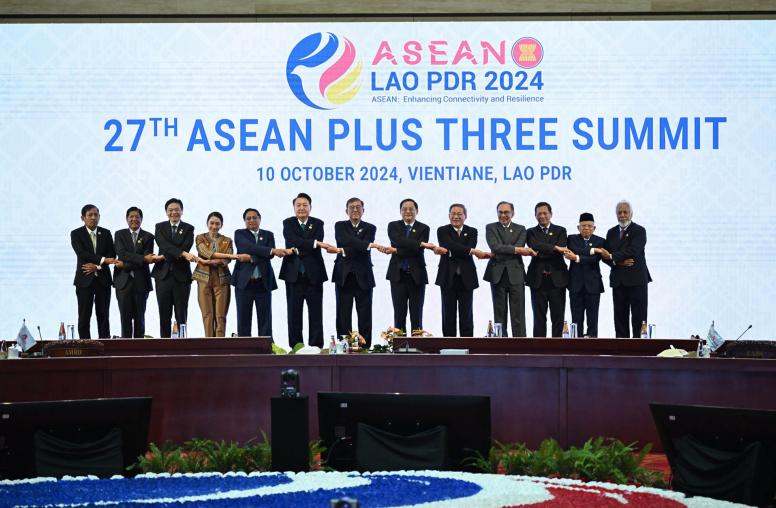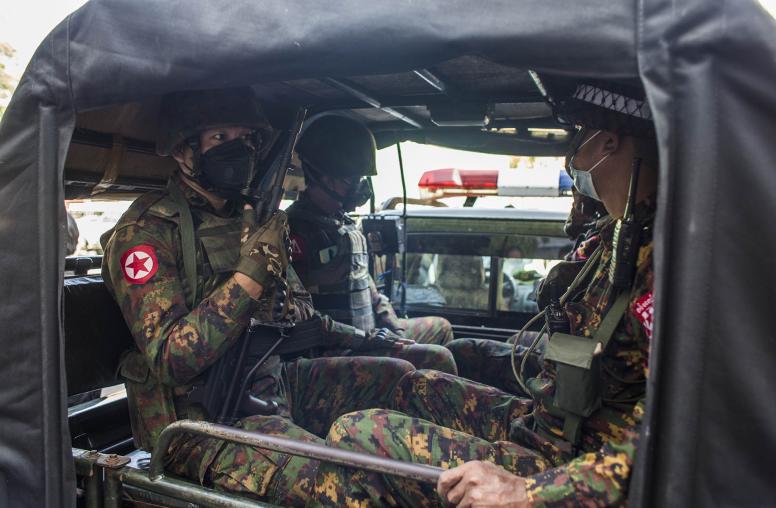China Bets Strategic Projects, Regional Stability on Myanmar Coup Regime
Visiting Beijing’s foreign minister pushes Mekong countries to take sides in the nation’s civil conflict.
Chinese Foreign Minister Wang Yi’s visit to Myanmar last week was the first by a senior Beijing official since a military coup toppled Myanmar’s elected government in February 2021. Its ostensible purpose was to co-chair the foreign ministers meeting of a Chinese-led subregional framework known as the Lancang Mekong Cooperation Forum. Its deeper — though related — significance was to deliver a crystal-clear message on the conflict raging in Myanmar: China has chosen to bolster Myanmar’s military in its fight against a rapidly growing popular resistance movement and will support the junta’s position within key multilateral platforms.

China is betting that assisting the military will promote rapid resumption of its geo-strategic economic projects through Myanmar and help broaden its influence in South and Southeast Asia. In contrast, Beijing views the pro-democracy National Unity Government (NUG) and allied ethnic armed organizations (EAOs) as revolutionary obstacles: too weak to defeat the regime but strong enough to delay China’s plans to economically harness Myanmar to its southwestern provinces.
China’s strategy vis-à-vis the junta represents a growing threat to security in the Indo-Pacific region. Support and legitimization for the military regime risks provoking greater violence in Myanmar and pushing any peaceful solution to the conflict out of reach. Myanmar’s neighbors will be forced to bear significant costs as the violence ripples across Myanmar’s borders and through the region.
As China pushes Mekong countries to deepen ties with the military regime, the Association for Southeast Asian Nations (ASEAN) risks losing the opportunity to play honest broker between the junta and the resistance, undermining any prospects of a true consensus emerging between ASEAN member states and further paralyzing the regional response.
The opportunity is rapidly shrinking for the United States and key regional partners to proactively bring this situation under control. At the center of any response will be challenging China over putting its economic projects ahead of Myanmar’s need to end the military’s violence and advance reconciliation and inclusive dialogue. Such an effort might ultimately lead China to recognize the danger of entrusting the economic security of its southwestern provinces to a savage, illegitimate and ineffective regime.
A High-Speed Train to War
While Beijing has ramped up business dealings with the military’s proxy government since hosting the junta’s top diplomat in April, the army has continued to lose ground to resistance forces over the past three months. Its control has particularly eroded in the Sagaing and Magway regions, where People’s Defense Forces have driven the majority of the junta’s administrators from their posts.
Now fighting wars on seven distinct fronts, the military has sustained significant battlefield losses. At the same time, its capacity to recruit and train new troops has all but evaporated, triggering the desperate step of dismantling key police functions across the country and sending police officers to the front lines. This leaves the regime increasingly reliant on airpower to maintain positions in six key states and regions — a tactic that fuels humanitarian and economic crises and further infuriates the population.
While China has continued paying lip service to dialogue-based solutions to the crisis, in practice it has downgraded interactions with the National League for Democracy Party (NLD) and denied the NUG any legitimacy even as it demands protection for its strategic investments. In contrast to last September, when China’s Communist Party (CPC) publicly invited the NLD to join a key convening of political parties, the NLD has not been featured at any subsequent CPC events, including the World Political Parties Summit held last week.
Central to China’s calculations is the urgency of its southwestern provinces to meet targets set by state planners over the past decade for cross-border projects in Myanmar.
Slowing Growth
For Yunnan Province in particular, completing strategic infrastructure that connects the provincial capital of Kunming to the Indian Ocean — while upgrading the existing China-Myanmar energy corridor — is seen as key to improved growth and security. The stakes for Yunnan rose significantly after Party Secretary Xi Jinping’s high-profile visits to the province and Myanmar in 2019 and 2020. By late 2021, Yunnan officials began observing a slowdown in growth that threatened progress toward their development goals.
When the military began signaling in October of 2021 its intentions to rapidly advance China’s coveted development projects, Yunnan-level officials saw a chance to win quick approval for their plans. As ties between the junta and China warmed in April following China’s hosting of the regime’s “foreign minister” for a bilateral visit, the junta took public steps to push forward two of China’s most important connectivity efforts: a dual use port on the Indian Ocean at Kyaukphyu, and the Muse-Mandalay Railroad Project. In May and June, the junta advanced assessments on these projects, generating a positive response from China, which took advantage of last week’s ministerial visit to sign a series of cooperative agreements with the military’s proxy government.
Conflict Challenges
While the junta is eager to break ground on these projects, it is important to recognize the challenges inherent to any form of large-scale infrastructure development in Myanmar given the intensity of the civil war.
To simply maintain control over key infrastructure projects — in part from seizure by local communities pushing for a return to elected government — the junta has been forced to deploy large numbers of troops. The most egregious case of military intervention involves the Letpedaung copper mine owned by the Chinese company Wanbao Mining. The junta placed troops inside the company’s headquarters and used it as a base for attacks on communities challenging military control. Wanbao thus became an accessory to human rights violations and war crimes and a party to the ongoing civil war.
There is every reason to believe any new projects will result in similar violence as force is the military’s only tool for addressing community opposition. Levels of conflict are predicted to be especially intense around the railroad project, as the military has no control of large parts of Magway — a key region the proposed line must eventually pass through if it is to link Mandalay to the Kyaukphyu Port.
Equally serious for the railroad project is the situation in Shan State. While the military faces a complex web of armed ethnic groups there, rival EAOs in the northern and southern parts of Shan are also battling for control and influence, particularly over key logistics corridors.
China-ASEAN Frictions
While China is beyond doubt the key international stakeholder supporting the junta, Beijing prefers not to be seen as acting bilaterally or without the backing of regional institutions. China’s initial strategy was to lean on ASEAN, arguing that the principle of ASEAN centrality made it the proper multilateral space to address the crisis. This helped keep the issue out of the United Nations Security Council and required that states pushing for more robust responses worked within the confines of ASEAN’s consensus-based framework.
ASEAN announced a five-point consensus on Myanmar in April of 2021 but it is a consensus in name only, with key divisions arising especially between the maritime and mainland states. The former are concerned about human rights violations and the junta’s refusal to engage the opposition in dialogue. The riparian states are largely authoritarian, with Cambodia and Laos in particular aligning themselves fully with China on geo-political issues.
Throughout most of 2021, China pushed ASEAN’s maritime members to support the junta’s plan for addressing the crisis: assembling a pro-military elections commission, co-opting some lesser EAOs into a peace process, moving ahead with economic projects, and finally holding fraudulent elections to empower a military proxy-party government. To China’s frustration, key maritime states, especially Malaysia and Indonesia, rejected the junta’s roadmap and demanded ASEAN dialogue with the opposition.
When Cambodia took over as ASEAN chair late last year, China initially thought it might leverage Cambodia’s capture of the ASEAN special envoy position to move the bloc toward legitimizing and recognizing the junta. Faced with continued pushback from the maritime states, Cambodia has proven indecisive — and even fickle — in its role as chair and special envoy, with Prime Minister Hun Sen even announcing that Cambodia will “throw in the towel” on Myanmar.
The LMC Consensus: Recognizing the Junta
Blocked at ASEAN, China looked to the Lancang Mekong Cooperation Forum (LMC) for regional institutional backing. Founded in 2016 as a vehicle to deepen Chinese involvement in the Mekong region, the LMC includes countries on the river and is particularly focused on water resource development. (China’s segment is referred to as the Lancang.) Unlike ASEAN’s maritime countries, none of the Mekong nations show reluctance about strengthening ties with the Myanmar army.
With the Ukraine conflict largely preoccupying the West, China and the junta quietly organized the seventh LMC Foreign Ministers’ Meeting, making the plans public only days before Wang Yi arrived in Myanmar. China could have easily hosted the meeting as it did in 2021 when Laos was the joint chair. Instead, it pushed for the Myanmar junta to host in its role as co-chair.
Convening the meeting in Myanmar represents a major challenge to ASEAN. Four ASEAN states joined China last week in a high-level meeting with the junta’s senior representatives. This badly undercuts ASEAN’s strategic decision to deny junta participation in high-level meetings and further weakens the organization’s leverage after the regime’s diplomatic gains with LMC members. It has also emboldened the junta in confronting the opposition, leading the NUG to demand the Mekong countries avoid any LMC meetings involving the junta.
An Opportunity for Bolder Action
Providing the junta with another boost, China announced at the meeting plans to host the LMC Leaders’ Summit in Myanmar before the end of the year, further undercutting ASEAN’s efforts to stop the violence, and making the Myanmar issue an increasingly serious regional security threat.
What else can the United States and its allies do as they also face a greater challenge in trying to restore democracy in Burma?
Three actions might be considered:
- Raise the Myanmar issue through the Greater Mekong Region’s dialogue partnership programs, including the Mekong-U.S. Partnership, the Japan-Mekong Cooperation and the Mekong-Australia Partnership;
- Open dialogue with China on the need to prioritize peace over its strategic economic initiatives; and
- Provide greater support to maritime states such as Malaysia and Indonesia that seek inclusive approaches that engage directly with the NUG and opposition stakeholders.
Ultimately, China is likely to discover that the junta’s use of violence and coercion to advance infrastructure projects will not succeed, regardless of regime diplomatic gains. While China might be able to absorb the costs of a bad bet on the junta, it will be Myanmar’s people who pay the price.



